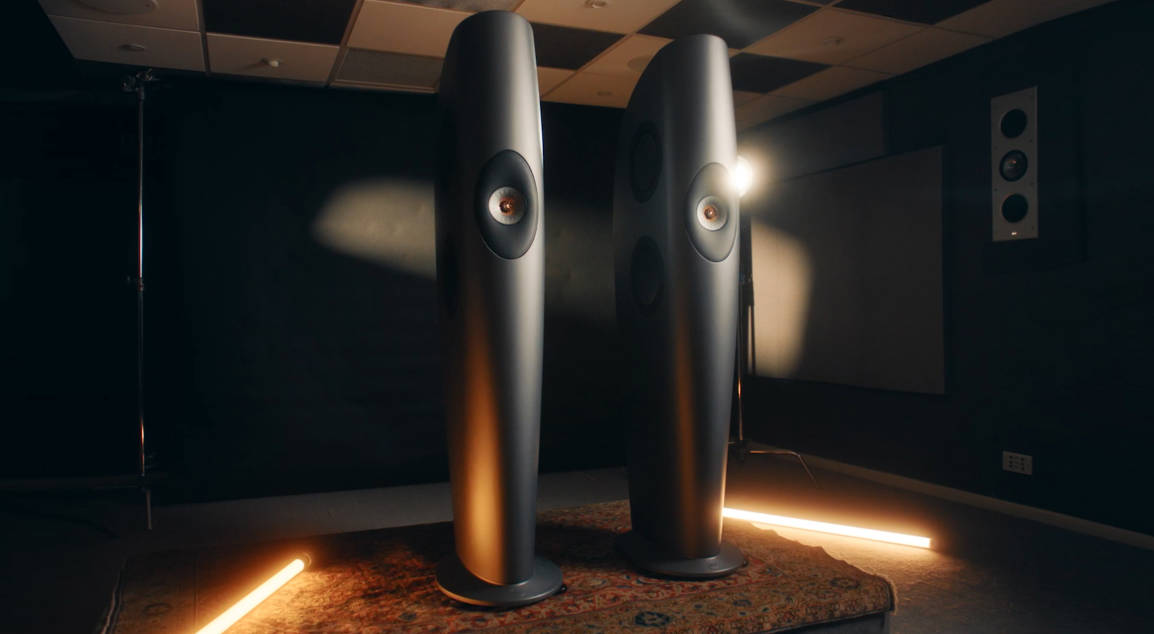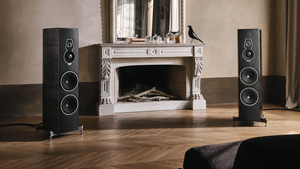
An In-Depth Review of the KEF Blade One Meta
I. Introduction: The Pursuit of a Single Voice
In the uppermost echelons of high-fidelity audio, there are products that perform, and then there are those that make a statement. The KEF Blade is unequivocally the latter. More than a decade after its initial unveiling as a radical "no constraints" concept, its silhouette remains as startling and futuristic as ever. It is less a conventional loudspeaker and more a piece of modernist sculpture, a graceful, parabolic form that seems to cleave the very air it is designed to move. Yet, this is no mere exercise in aesthetic indulgence. The Blade is the physical manifestation of a singular, audacious idea—an unwavering, science-driven pursuit of an acoustic holy grail: the Single Apparent Source.

The central thesis behind the Blade is as elegant as its form. In a conventional loudspeaker, the tweeter, midrange, and woofers are physically separated on a flat baffle. Sound from each driver originates from a different point and travels a slightly different path to the listener's ear. This creates subtle but critical timing and phase discrepancies, particularly at the crossover frequencies, which can compromise the stability and coherence of the stereo image. KEF’s ambition with the Blade was to create a full-range loudspeaker where the acoustic centre of every driver—from the deepest bass to the highest treble—occupies the exact same point in space. The goal is to have all frequencies arrive at the ear simultaneously, as they would from a single, perfect, pulsating sphere. This is the key to unlocking a truly holographic soundstage, where the speakers themselves dissolve and leave only the music, suspended in a three-dimensional acoustic space.
Now, in its latest incarnation as the Blade One Meta, this iconic design enters a new chapter. The "Meta" designation signifies the inclusion of KEF's groundbreaking Metamaterial Absorption Technology (MAT), a development that promises to elevate the performance of its signature Uni-Q driver to an unprecedented level of purity. This is not an incremental update but a fundamental enhancement, aimed at eradicating a final layer of distortion and bringing the Blade concept closer to its theoretical ideal than ever before.

To understand the Blade One Meta is therefore to engage with a specific philosophy of sound reproduction. It represents a belief that temporal coherence and controlled dispersion are the paramount virtues in achieving sonic realism. This review will embark on a journey to explore that philosophy in practice. We will dissect the Blade's unique anatomy, connecting each engineering choice to its foundational goal. We will then immerse ourselves in a detailed audition, articulating its sonic character and addressing the often-contradictory reports of its performance. Finally, we will place this modern classic in the context of its most formidable peers, evaluating its unique proposition in a field of titans.
II. Anatomy of an Icon: Technology and Design
Every curve, every component, and every engineering decision in the Blade One Meta is subservient to the Single Apparent Source principle. It is a masterclass in holistic design, where technology is not merely applied but is born from a foundational acoustic concept.
The Uni-Q Perfected: A Point in Space
At the heart of the Blade, both physically and philosophically, lies the 12th Generation Uni-Q driver array. This is KEF's most advanced expression of the coaxial driver, placing a 25 mm vented aluminium dome tweeter precisely at the acoustic centre of a 125 mm aluminium cone midrange driver. This ingenious configuration ensures that the critical midrange and high frequencies emanate from the exact same point, eliminating the off-axis interference patterns that plague traditional, spatially separated drivers. This is the first and most critical step in creating a true point source, responsible for the speaker's famously stable and precise imaging.
The "Meta" evolution of this driver introduces a truly revolutionary element: Metamaterial Absorption Technology (MAT). Situated directly behind the tweeter is a small, intricate disc that resembles a maze. This is the metamaterial absorber. Its complex, channelled structure is engineered to act as an "acoustic black hole," absorbing an astonishing 99% of the unwanted sound radiating from the rear of the tweeter dome. In a conventional design, this rearward energy reflects off the motor structure and back through the delicate dome, creating audible distortion and resonance that clouds detail and imparts a harsh, artificial edge to the sound. By effectively eliminating this distortion at the source, MAT allows the tweeter to perform with a purity and naturalness that is simply breathtaking. Further refining the driver's output is KEF's signature 'tangerine' waveguide, which is integrated into the tweeter's faceplate to meticulously control dispersion, ensuring a wide, even, and consistent soundfield that creates an exceptionally broad listening "sweet spot".

Symmetrical Force: Bass Without a Trace
To complete the Single Apparent Source geometry, KEF's engineers had to solve the conundrum of integrating powerful bass drivers without compromising the point-source ideal. Their solution is as radical as it is effective. The Blade One Meta employs four potent 225 mm (9-inch) aluminium cone woofers, but instead of mounting them on the front baffle, they are arranged in two opposing pairs, back-to-back on the slender sides of the cabinet. This is KEF's force-cancelling configuration.
The principle is rooted in basic physics. As the cones move in and out, the powerful reactive forces they generate—the vibrations that would normally excite a speaker cabinet and cause it to resonate—are equal and opposite. They effectively cancel each other out, leaving the cabinet almost entirely inert. The benefit of this design is profound. By preventing the cabinet from becoming a secondary, unwanted source of sound, the bass reproduction is rendered with extraordinary clarity, speed, and articulation. The low frequencies are powerful and dynamic, yet remain exceptionally tight and controlled, free from the boom, overhang, or smearing that can plague even very expensive conventional designs. This acoustic inertia also liberates the industrial design, allowing for the Blade's lightweight, sculpted form, as there is far less need to damp resonances with sheer mass.
Most importantly, this clever arrangement allows the acoustic centre of the four-woofer array to be geometrically co-located with the acoustic centre of the Uni-Q driver. This is the final piece of the puzzle. From the deepest notes of a pipe organ to the highest shimmer of a cymbal, the sound appears to radiate from a single, coherent point in space, achieving a level of temporal alignment across the entire audible spectrum that few loudspeakers can match.

Form as Function: The Sculpted Cabinet
The Blade's dramatic, blade-like profile is the most direct visual expression of its acoustic purpose. The continuously curved, narrow front baffle is the antithesis of the large, flat panels found on most speakers. This shape is acoustically necessary, providing an almost vanishingly small surface around the Uni-Q driver to minimize baffle diffraction. Diffraction occurs when sound waves traveling across the front of a speaker hit a sharp edge, like the corner of a cabinet, creating a secondary, distorted wave source that smears sonic detail and corrupts the precision of the stereo image. By creating a smooth, edgeless form, KEF has all but eliminated this deleterious effect, allowing the Uni-Q driver to launch its sound into the room with unparalleled clarity. The cabinet itself is constructed from an advanced, high-density glass-reinforced composite, a material chosen for its extreme rigidity, inertness, and ability to be moulded into the complex, parabolic curves required by the design.
KEF Blade One Meta Technical Specifications
To provide a clear, objective foundation for the listening analysis, the manufacturer's official specifications are consolidated below.
| Specification | Detail |
| Design | Three-way bass reflex, Single Apparent Source |
| Drive Units | Uni-Q driver array: HF: 25 mm (1 in.) aluminium dome with MAT, MF: 125 mm (5 in.) aluminium cone. Bass units: LF: 4 x 225 mm (9 in.) aluminium cone, force cancelling. |
| Frequency Response (±3dB) | 35Hz - 35kHz |
| Frequency Range (-6dB) | 27Hz - 45kHz |
| Typical In-Room Bass Response (-6dB) | 20Hz |
| Crossover Frequencies | 350Hz, 2kHz |
| Amplifier Requirements | 50-400W |
| Sensitivity (2.83V/1m) | 88dB |
| Impedance | 4 Ω (min. 2.8 Ω) |
| Maximum Output (SPL) | 117dB |
| Dimensions (H x W x D) | 1590 x 363 x 540 mm (62.5 x 14.3 x 21.2 in.) |
| Weight | 57.2 kg (126 lbs.) |
III. The Audition: Sound, Space, and Sensation
The technical brilliance of the Blade One Meta is undeniable, but the ultimate measure of any loudspeaker is its ability to transcend its mechanical nature and communicate the emotional essence of music. It is here, in the listening room, that the Blade reveals its true character—a character that is both profoundly rewarding and uniquely demanding.
The Setup Imperative: Unlocking the Hologram
A survey of listener experiences with the Blade reveals a curious and telling contradiction. On one hand, there are reports, often from brief auditions in dealer showrooms, of disappointing performance. Listeners describe imaging that is "horrible," a soundstage that never extends beyond the physical boundaries of the speakers, and an inability for the speakers to "disappear" in the room. On the other hand, owners and reviewers who have spent considerable time with the speakers in a dedicated listening environment describe a completely different reality: a "huge," three-dimensional soundstage, an incredible point-source-like presentation, and a magical ability to vanish, leaving only a holographic musical performance in their place.
This stark divergence is not a matter of subjective preference; it points to a fundamental characteristic of the speaker's design. The Blade One Meta is not a "plug-and-play" device engineered to deliver an instantly gratifying "showroom sound." Instead, it behaves more like a fine musical instrument, whose ultimate performance is a co-creation between the inherent quality of the design and the skill and dedication of the person setting it up. The key to this puzzle lies in the specific dispersion characteristics of the Uni-Q driver. Unlike many conventional drivers that sound their best when aimed directly at the listener, KEF's coaxial driver often achieves its most open, airy, and spacious presentation with little to no toe-in. The typical showroom setup, with speakers aggressively angled towards the listening chair, can inadvertently place the listener in a null of the speaker's optimal dispersion pattern, leading to the very imaging issues described in the negative reports. The Blade One Meta withholds its ultimate magic until its placement in the room is just so. This is not a flaw, but a defining trait. It is a speaker designed not for the casual consumer, but for the dedicated audiophile who views system setup as an integral and rewarding part of the pursuit of sonic perfection.

Clarity and Colour: The Midrange and Treble
Once properly positioned, the Blade One Meta delivers a midrange and treble performance of astonishing purity. The effect of the Metamaterial Absorption Technology is immediately apparent. Vocals, strings, and brass instruments emerge from a silent, "black" background with a complete lack of electronic artifice. The sound is exceptionally clean and transparent, yet entirely free of the sterile or analytical quality that can sometimes accompany high-resolution audio. There is a naturalness and ease to the presentation that is utterly captivating.
The coherence afforded by the Uni-Q driver is exemplary. The transition between the midrange and tweeter is seamless, creating the powerful illusion of a single, unified voice. This is the essence of the point-source ideal realized in practice: the sound is not perceived as coming from separate high- and mid-frequency drivers, but as an integrated, organic whole. This contributes to a stable, unwavering focus that casts an almost hypnotic spell, drawing the listener deep into the performance. The overall character is one of sophisticated neutrality. The Blade does not seek to impress with artificial warmth or exaggerated detail. Some listeners might even describe its initial presentation as "mellow" or polite compared to more overtly colored designs. This, however, is the hallmark of a speaker engineered for accuracy and long-term enjoyment. It is a sound that never fatigues, inviting hours of deep, immersive listening without a hint of strain.
Power with Poise: Dynamics and Low Frequencies
Any notion of politeness is immediately dispelled when the music calls for power and scale. The low-frequency performance of the Blade One Meta is nothing short of breathtaking. The four force-cancelling woofers deliver bass that is not only heard but felt—a visceral, physical presence that can energize a room with thunderous impact, delivering what one reviewer aptly described as a "bass massage". It is a truly full-range experience, with an in-room response that extends down to a subterranean 20Hz.
Yet, this immense power is wielded with absolute precision and control. Thanks to the vibration-cancelling design, the bass is remarkably tight, articulate, and tuneful. There is no sense of bloat, overhang, or cabinet-induced boominess, even when the speakers are positioned relatively close to room boundaries. Instead, one hears the texture of a bass guitar string, the resonant skin of a kick drum, and the distinct pitch of the lowest organ pedals. This combination of power and poise allows the Blade to render large-scale orchestral works and dynamic electronic music with a sense of unlimited scale and authority. Complex musical passages remain perfectly organized and intelligible, even at concert-level volumes. The speakers never sound compressed or strained; they simply expand to meet the dynamic demands of the music, creating a soundfield that is both gigantic and impeccably composed.

IV. The Field of Titans: A Competitive Analysis
The KEF Blade One Meta operates in a rarefied market segment populated by some of the most respected and technologically advanced loudspeakers in the world. To fully appreciate its unique strengths, it is essential to compare it against its key rivals, each of which represents a different, yet equally valid, philosophy of high-end sound reproduction.
Competitive Snapshot
The following table provides a high-level overview of the Blade One Meta and its primary competitors, highlighting their core philosophies, key technologies, and distinct sonic signatures.
| Feature | KEF Blade One Meta | Bowers & Wilkins 801 D4 | Wilson Audio Sasha V | Focal Scala Utopia Evo |
| Core Philosophy | Single Apparent Source; Coherence & Controlled Dispersion | Studio Monitor Accuracy; "House Sound" with Elevated Detail | Time-Domain Alignment; Cabinet Material Science | Exotic Driver Materials; Dynamic Realism & "Hi-Fi Pyrotechnics" |
| Key Technology | 12th Gen Uni-Q with MAT; Force-Cancelling Woofers | Diamond Dome Tweeter; Continuum FST Midrange; Turbine Head | Adjustable Upper Module; Proprietary X & V-Material; CSC Tweeter | Beryllium Inverted Dome Tweeter; 'W' Sandwich Cone; TMD & NIC |
| Aesthetic | Sculptural, Modernist | Iconic, Industrial, Functional | Angular, Modular, Robust | Articulated, Automotive-inspired |
| Sonic Signature | Coherent, Neutral, Transparent, Huge Soundstage (when set up) | Highly Detailed, Authoritative, Powerful Bass, Forward Treble | Dynamic, Tonally Rich, Precise Imaging, Deep Bass | Vivid, Fast, Crystal-Clear Highs, Expressive Midrange |
| Approx. Price | ~$35,000 | ~$35,000 | ~$49,000 | ~$40,000 (after price drop) |
KEF Blade One Meta vs. Bowers & Wilkins 801 D4: The Neutralist vs. The Monitor
This comparison represents a classic philosophical divide in British loudspeaker design. The Blade One Meta is the culmination of KEF's pursuit of measured neutrality and point-source coherence, while the Bowers & Wilkins 801 D4 carries the legacy of its role as a studio reference monitor, which has evolved into a distinct "house sound" prized for its authority and heightened sense of detail.
Their technological approaches are diametrically opposed. KEF's design is one of integration, with the Uni-Q and force-cancelling woofers all acoustically aligned to a single point. B&W's philosophy is one of isolation. Its iconic design separates each driver into its own optimized enclosure: the Diamond Dome tweeter resides in a solid, tube-loaded aluminum housing; the Continuum FST midrange operates from the acoustically deadened Turbine Head; and the twin Aerofoil bass drivers are mounted in a massively braced Matrix cabinet.
These differing approaches yield distinct sonic presentations. The 801 D4 is often described as having exceptional "snap" and speed, with a forward, highly resolving character that uncovers every nuance in a recording. Its treble, courtesy of the diamond dome, is exceptionally extended and energetic, though some listeners find it fatiguing over long sessions. While its bass is immensely powerful, some report a subtle sense of disconnect between the low frequencies and the midrange when compared to the Blade's seamless presentation. The Blade, in contrast, offers a smoother, more tonally continuous sound from top to bottom. Its soundstage is wider and more immersive, with a broader sweet spot that is less "beamy" than the B&W's more focused presentation. In a brief A/B comparison, the B&W might initially impress with its "wow factor" and incisive detail, but the KEF's strength lies in its ability to create a more believable, coherent acoustic space that invites long-term, fatigue-free immersion.

KEF Blade One Meta vs. Wilson Audio Sasha V: Integrated Sculpture vs. Modular Mechanics
The contrast with the Wilson Audio Sasha V is one of form and material science. Where KEF achieves temporal alignment through the integrated, fixed geometry of the Single Apparent Source, Wilson employs a modular approach. The Sasha V's upper enclosure, housing the midrange and tweeter, is physically adjustable relative to the lower woofer cabinet, allowing for precise time-domain alignment tailored to the specific listening position. This is a different mechanical path to the same acoustic goal.
Wilson Audio is also renowned for its fanatical attention to cabinet materials, utilizing proprietary, ultra-dense composites known as X-Material and V-Material to achieve an extraordinary level of enclosure inertness. KEF achieves a similar goal through the clever physics of its force-cancelling woofer arrangement. Sonically, Wilson speakers are celebrated for their explosive dynamics, rich tonal saturation, and uncanny ability to render images with pinpoint precision within the sweet spot. Compared to the Blade Meta, the Sasha V may offer a more "meaty," timbrally dense, and emotionally direct presentation. The choice between them may hinge on a preference for the Wilson's powerful, visceral sound versus the KEF's more spacious, transparent, and ethereal character. While both are exceptionally resolving, some listeners find Wilson's voicing to be more "idiosyncratic" and less strictly neutral than KEF's science-led approach.
KEF Blade One Meta vs. Focal Scala Utopia Evo: Aluminum Purity vs. Beryllium Bite
The battle with the Focal Scala Utopia Evo is largely a contest of driver material philosophies. KEF has spent decades refining its aluminum drivers to a state of near-perfection, now augmented by MAT. Focal, on the other hand, champions the use of more exotic materials, most notably its signature Beryllium inverted dome tweeter and its 'W' sandwich cones, which use a composite of glass fiber and foam.
This results in noticeably different sonic flavors. Focal speakers are consistently praised for being exceptionally fast, dynamic, and vivid. The Beryllium tweeter delivers a treble that is crystal-clear, incredibly extended, and possessed of a sharp, crystalline quality. For many, this is the pinnacle of high-frequency reproduction, though some find it can border on bright or analytical—what one listener termed "hifi pyrotechnics". The Blade One Meta, with its MAT-damped aluminum dome, offers a presentation that is arguably smoother and more natural in the top octaves, prioritizing timbral purity over ultimate incisiveness. Aesthetically, the Blade's singular, fluid form contrasts with the Scala's articulated, multi-box "Focus Time" construction, which, like the Wilson, allows for mechanical time alignment. It is also worth noting the significant practical difference in weight: the Scala Utopia Evo is a far more massive and challenging speaker to install at 85 kg (187 lbs) compared to the Blade's more manageable 57.2 kg (126 lbs).
V. Conclusion: The Verdict on a Modern Classic
The KEF Blade One Meta is a profound achievement in loudspeaker design. It succeeds not only as a high-performance transducer but as the triumphant realization of a deeply held acoustic philosophy. It stands as one of the most compelling and intellectually satisfying offerings in the ultra-high-end audio landscape.

Summary of Strengths
The speaker's core triumphs are inextricably linked to its foundational design. The Single Apparent Source concept delivers on its promise, producing a soundfield of unparalleled coherence and spatial realism. This is further enhanced by the 12th Generation Uni-Q driver with Metamaterial Absorption Technology, which provides a window into the music of pristine clarity and transparency, free from mechanical artifacts. This delicacy is underpinned by a bass system that is a marvel of engineering, delivering a potent combination of depth, power, and impeccable control that is both viscerally exciting and musically articulate. Finally, the Blade One Meta must be celebrated as a landmark of industrial design, a rare instance where a radical and beautiful form is a direct and necessary consequence of its acoustic function.
Acknowledging the Caveats
The Blade One Meta's greatest strength—its uncompromising design—is also the source of its primary caveat. It is a demanding loudspeaker. Its ultimate performance is highly contingent on careful placement and synergy with the listening room. It will not deliver its best in a casual or compromised setup, and may underwhelm those accustomed to the instant gratification of speakers with a more forgiving or colored presentation. Its honest and neutral tonality, while a benchmark for accuracy, may also lack the overt "excitement" that some listeners crave. These are not flaws, but rather defining characteristics that must be understood and embraced by a potential owner.

The Ideal Listener
This brings us to the question of who this speaker is for. The KEF Blade One Meta is not for everyone, even among those with the requisite budget. It is for the discerning audiophile who has moved beyond the pursuit of mere sonic effects and seeks a deeper, more fundamental connection to the music. It is for the listener who values coherence, spatial accuracy, and technological innovation, and who understands that achieving the last measure of performance requires personal engagement. The ideal owner is a connoisseur who will relish the process of dialing in the setup, knowing that the reward is a truly holographic and immersive musical experience. They are seeking a reference instrument, not just an audio appliance.
Final Statement
In the final analysis, the KEF Blade One Meta is a modern classic. It is a testament to what is possible when a visionary acoustic concept is pursued with unwavering scientific rigor and aesthetic grace. It does not simply play music; it reconstructs the time, the space, and the very fabric of the original performance with a coherence and realism that is, at times, utterly breathtaking. For the listener whose goals align with its philosophy, the Blade One Meta is not just an endgame loudspeaker; it is a destination.






Comments